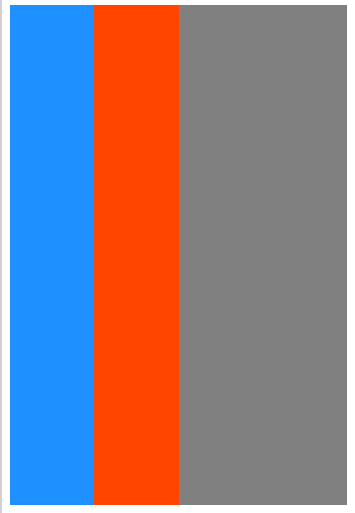FCC---CSS Flexbox: Align Elements Using the justify-content Property
Sometimes the flex items within a flex container do not fill all the space in the container. It is common to want to tell CSS how to align and space out the flex items a certain way. Fortunately, the justify-content property has several options to do this. But first, there is some important terminology to understand before reviewing those options.
Here is a useful image showing a row to illustrate the concepts below.

Recall that setting a flex container as a row places the flex items side-by-side from left-to-right. A flex container set as a column places the flex items in a vertical stack from top-to-bottom. For each, the direction the flex items are arranged is called the main axis. For a row, this is a horizontal line that cuts through each item. And for a column, the main axis is a vertical line through the items.
There are several options for how to space the flex items along the line that is the main axis. One of the most commonly used is justify-content: center;, which aligns all the flex items to the center inside the flex container. Others options include:
flex-start: aligns items to the start of the flex container. For a row, this pushes the items to the left of the container. For a column, this pushes the items to the top of the container. This is the default alignment if nojustify-contentis specified.flex-end: aligns items to the end of the flex container. For a row, this pushes the items to the right of the container. For a column, this pushes the items to the bottom of the container.space-between: aligns items to the center of the main axis, with extra space placed between the items. The first and last items are pushed to the very edge of the flex container. For example, in a row the first item is against the left side of the container, the last item is against the right side of the container, then the remaining space is distributed evenly among the other items.space-around: similar tospace-betweenbut the first and last items are not locked to the edges of the container, the space is distributed around all the items with a half space on either end of the flex container.space-evenly: Distributes space evenly between the flex items with a full space at either end of the flex container
An example helps show this property in action. Add the CSS property justify-content to the #box-container element, and give it a value of center.
Bonus
Try the other options for the justify-content property in the code editor to see their differences. But note that a value of center is the only one that will pass this challenge.
换上上面提到的几个属性,都可以操作,体会实际效果~
from:

to:



FCC---CSS Flexbox: Align Elements Using the justify-content Property的更多相关文章
- CSS Flexbox 学习指南、工具与框架
Flexbox 是一种更有效的布局方式,它能更好的分配容器空间,并控制项目的对齐.虽然,掌握它的理论有些复杂,但幸运的是,我们可以借助开放的网络来学习并逐步掌握它. 在本文中,我们整合了一些最佳的 F ...
- CSS Flexbox 弹性盒子模型
CSS Flexbox 弹性盒子模型 设置元素样式为 display: flex 或 display: inline-flex, 让元素变成flex容器, 从而可以通过flex模式布局它的子元素. f ...
- CSS#Flex-box, border-size, onresize() event, Media Queries
Flexbox Pseudo-classes box-sizing: border-box HTML DOM event resize() @media Queries: 根据一些css条件,触发一 ...
- css flexbox 弹性布局
flexbox 即css flexible box layout. ie9及以下不支持flexbox. flex详细规范(https://www.w3.org/TR/css-flexbox/) 为什么 ...
- CSS: Flexbox
Use flexbox to create a responsive website, containing a flexible navigation bar and flexible conten ...
- 使用css Flexbox实现垂直居中
CSS布局对我们来说一直是个噩梦,我们都认为flexbox是我们的救世主.是否真的如我们说说,还有待观察,但是flexbox确非常轻松的解决css长久一来比较难解决的居中问题.让我们来看看到底有多容易 ...
- [CSS] Target empty elements using the :empty pseudo-class
You can target an element that has no child elements by using the :empty pseudo-class. With browser ...
- [CSS] Dynamically Size Elements with Pure CSS
Learn how to size elements based on the dimensions of the viewport, even when the browser is resized ...
- [CSS] Target Positional Elements Using *-Of-Type CSS pseudo-classes
Learn how to target elements based on their position inside of a parent element in relation to its s ...
随机推荐
- Python和BeautifulSoup进行网页爬取
在大数据.人工智能时代,我们通常需要从网站中收集我们所需的数据,网络信息的爬取技术已经成为多个行业所需的技能之一.而Python则是目前数据科学项目中最常用的编程语言之一.使用Python与Beaut ...
- 如何搭建Docker私有仓库
私有仓库 有时候使用 Docker Hub 这样的公共仓库可能不方便,用户可以创建一个本地仓库供私人使用. 本节介绍如何使用本地仓库. docker-registry 是官方提供的工具,可以用于构建私 ...
- C博客作业00—我的第一篇博客
C博客作业00-我的第一篇博客 1. 你对网络专业或者计算机专业了解是怎样? 泛泛了解 - 原先只知道网络工程隶属于计算机工程学院,与院中其他专业一样,同样都需要学习大量的计算机基础知识,然后再分支学 ...
- [UWP]UIElement.Clip虽然残废,但它还可以这样玩
1. 复习一下WPF的UIElement.Clip 用了很久很久的WPF,但几乎没有主动用过它的Clip属性,我只记得它很灵活,可以裁剪出多种形状.在官方文档复习了一下,大致用法和效果如下: < ...
- #在windows上使用ngix重定向目录访问远程服务器文件详细实例
为了在开发环境保持于生产环境相同的访问远程服务器文件资源的目录配置,需要在开发环境(windows)在远程文件服务器使用nignx重定向文件目录,因为网上的资料大都是copy的,解释比较笼统,也没有具 ...
- JVM虚拟机详解+Tomcat性能优化
1.JVM(java virtual mechinal) ()JVM有完善的硬件架构,如处理器.堆栈.寄存器当,还具有相应的指令系统. ()JVM的主要工作时解释自己的指令集(即字节码),并映射到本地 ...
- MySQL-简介-安装(5.5版和5.7版)
1.什么是MySQL (1)MySQL是一种关联数据库管理系统. (2)关联数据库将数据保存在不同的表中,而不是将所有数据放在一个大仓库中,可以增加速度,提高灵活性. (3)MySQL使用的是数据库常 ...
- 阿里云安装mysql
1. ##数据库字符集SHOW VARIABLES LIKE 'character_set_%'; ##数据库校对股则SHOW VARIABLES LIKE 'collation_%'; 2.创建数据 ...
- adb adb monkey命令及介绍
1.adb的组成部分 守护进程,客户端,服务器端` 2.Monkey程序是Google公司提供的一个压力和稳定性测试的工具 3.命令 命令 参数 功能 adb version 查看当前a ...
- 性能达到原生 MySQL 七倍,华为云 Taurus 技术解读【华为云技术分享】
版权声明:本文为博主原创文章,遵循CC 4.0 BY-SA版权协议,转载请附上原文出处链接和本声明. 本文链接:https://blog.csdn.net/devcloud/article/detai ...
